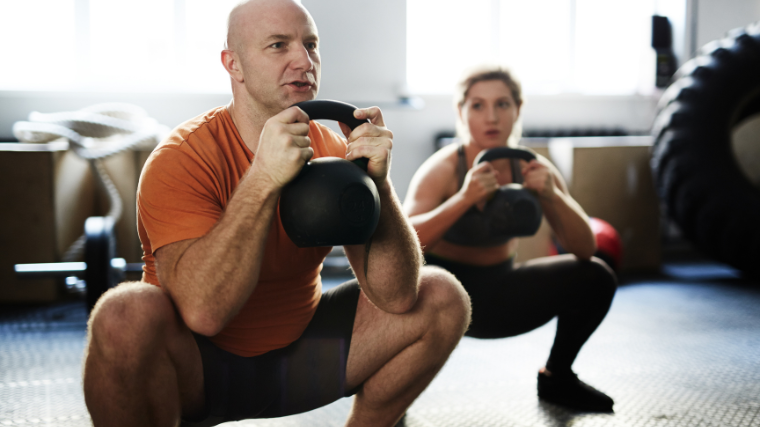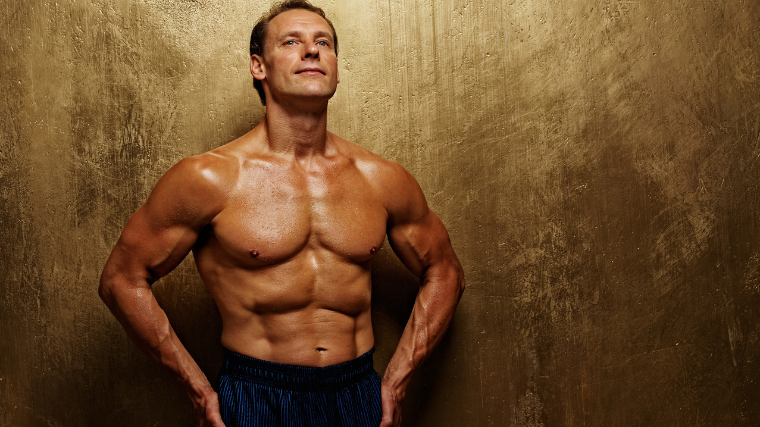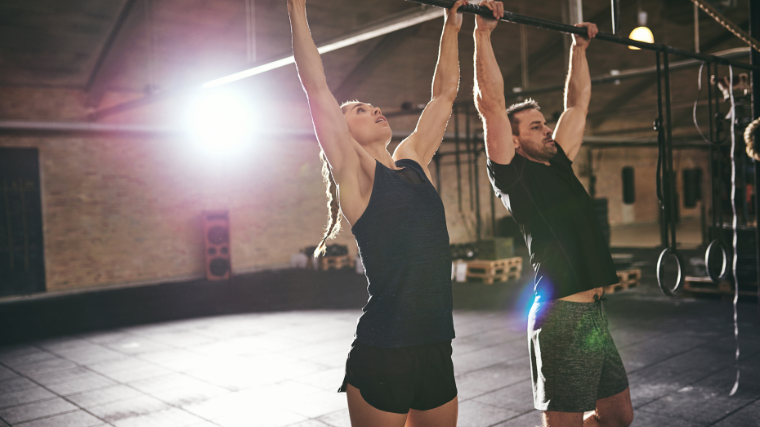You might falsely think that resistance training is a young man’s (or woman’s) game — this could not be further from the truth. Being “over the hill” may seem like a deterrent, but there is absolutely nothing stopping you from getting into the weight room and making some serious gains, regardless of how many notches you’ve got on your belt.
You should, however, be realistic about your prospects. If you’re nearing (or have passed) your 40th birthday, there’s a good chance you’ve got more on your plate than just managing your workout routine.
A career, your family, and some longstanding achy joints may seem like too much to overcome, but luckily, you can still get into the gym (and get a lot out of your time there as well).

The key to making gains at or above 40 is acknowledging the differences between you and your 20-year-old self. Times have changed, and so have the rules. Here’s what the science has to say, and how you can get started.
How to Start Lifting Weights at 40
What the Science Says
Although there is a lack of direct research looking at how 40-somethings specifically respond to resistance training, there is a known age-related decline in overall muscle mass and strength as you age. (1) Fortunately, lifting weights appears to be the “solution”, as it helps to delay or offset things like reduced muscle tone, poor stability or bodily control, or joint degradation. (1)
You Can Still Build Muscle
17 and 70-year-olds alike can build muscle. The pace and magnitude of your gains might just be a bit different than someone 20 years your junior (or senior).
With each passing year you will experience greater anabolic resistance, meaning you won’t be as “sensitive” to resistance training over time. This doesn’t mean you’ll make no gains, but it does mean there has to be a greater emphasis on doing things right. (2)
You can, however, make great initial progress with significantly less volume or intensity than you think. Start by hitting all your major muscle groups twice per week with 1-3 sets of 8-12 repetitions at 60-70% of your 1-repetition maximum (1RM). (3)
This can serve as a foundation to launch into a more structured strength or hypertrophy program.
You Should Prioritize Recovery
Getting adequate protein is absolutely essential for gains, and its importance is only magnified as you creep closer to middle age. Anabolic resistance will also negatively affect how your body utilizes protein, meaning you’ll probably need a bit more than your younger counterparts. (2)
Shooting for a protein goal around one gram per pound of body weight can positively influence your results more than almost any other factor. (4)
Sleep is a weight training superpower, the unsung hero of gains. Most adults benefit from averaging between 7-9 hours of sleep, but some literature suggests that resistance training populations (especially when training more athletically) may require even more. (5) If you’re not able to consistently attain 7 to 9 hours of sleep, make it a priority.
Step 1 — Establish a Goal
How you approach fitness is going to be different than a teenager would. A younger lifter might be able to get away waltzing into the weight room and running themselves through a wall to make progress, but your exercise selection and training parameters will require a more delicate touch to best serve you at 40.
If you want to make progress, you need to know where you’re going specifically. Here are some factors to consider when you’re deciding what kind of lifting you want to do.
Strength and Power Training
While many lifters see strength and power strictly through powerlifting-tinted goggles, this doesn’t have to be the case. Strength or power training means picking a few key exercises and trying to increase the maximal amount of weight you can lift for anywhere between, usually, 1-6 repetitions.
One thing worth noting is that, unless you want to compete in a powerlifting meet, you don’t have to adhere to a few select movements. You can take strength-gain principles and apply them to movements you enjoy. The principles of strength gain apply equally, regardless of your age. (3)
Hypertrophy Training
Training for muscle gain can have a much broader set and repetition range than building strength. (6) This will be extremely important to maximize your progress, as certain muscle groups may be harder for you to train with heavy loading than if you were younger.
High-intensity sets that bring you close to muscular failure will build plenty of muscle, but sets of 12-20 repetitions might be more effective for you than sets in an heavier 8-10 repetition range, since they won’t beat you up as much over time.
Also, regardless of when you start lifting, you can still take advantage of “newbie gains,” meaning you can put on noticeable muscle without taking yourself to the brink every workout. (6)
Choosing an Implement
Another major distinction you should make is whether or not the barbell is right for you at all. Some alternative implements to consider are the trap bar, dumbbells, or kettlebells.
These tools might be better choices for you to get strong and fast with. A heavy goblet squat, trap bar deadlift, or kettlebell clean and pressing don’t have the same steep learning curve as their barbell counterparts. They are great options to start building your strength and power aside from focusing solely on the barbell.
Step 2 — Create a Schedule
It’s not a terrible idea to have a plan at any age, but with increased outside-of-the-gym responsibilities and likely smaller windows of opportunity to train, figuring out your session frequency, duration, and time of day will go a long way towards making a real difference in your results.
Exercise Frequency
Determining the appropriate training split to accommodate your goals, lifestyle, and ability to recover will be critical to your success. Missed workouts are particularly annoying when you already are operating on a more limited schedule, so you should make sure you’re on a program that has a manageable frequency.
When you’re first starting, you can make significant progress with as few as 2 or 3 training sessions per week. (3) Make sure they’re written down and made into non-negotiable priorities in your schedule.
You can always increase your frequency as your relationship with exercise evolves.
Workout Duration
Another huge factor to determine when starting out is how long you’ll be able to train during each workout. A proper warm-up and training session can take anywhere from 30 minutes to an hour or longer, but you don’t have to do everything in one big workout necessarily.

Seeing health benefits can be as simple as getting multiple short bouts of exercise throughout the day depending on your fitness level and goals. (7) Two or three 20-minute workouts can be surprisingly potent.
Prioritization
Setting a designated a time of the day can be helpful for making your training just that — training, not mindlessly exercising. Learning to dissociate training time from other responsibilities is important for being able to stay focused on the task at hand.
Whether you’re a five-in-the-morning warrior or a lunch break lifter, as long as you make it a regular and reliable habit, you’ll be in good shape. Blocking off a consistent time for you to train will allow you to see the most progress and miss the fewest workouts.
Step 3 — Find Your Spot
Choosing the right place to train can help you feel the most comfortable and productive. The major options you’ll have are to create a home gym space, choose a commercial gym, or find a smaller, more private facility.
Home Gym
A home gym is one of the most convenient things you can have at your disposal to account for the unpredictability of life. It’s right at your fingertips at all times, you can have much more flexibility in workout timing, and you get the luxury of not having to share your space.
However, the major drawbacks are having (and maintaining) a physical space for what could be a significant amount of large equipment — plus the monetary cost.
Commercial Gym
A commercial gym will be the best for your buck when it comes to lifting weights. You’ll generally get a full complement of free weights and machines, and even some specialty equipment if you’re lucky.
Although there are the drawbacks of loud, crowded training areas, potentially waiting for equipment, and variable membership costs, a commercial gym is a safe and secure choice for an exercise space.
Semi-Private Facility
A semi-private facility, such as a strength sport gym or private personal training studio offers a happy medium between the two. The membership costs might be a bit more expensive than some commercial gyms, and the equipment may be a bit more niche, but you’ll be able to avoid a ton of crowded spaces and get more personal attention from the staff or coaches.
Depending on your personal preferences, a semi-private facility might be the best of both worlds.
Step 4 — Start Slowly
The first step of anything is always the hardest. Fortunately, just because you’ve got a few more years behind you doesn’t mean you’re immune to the positive impact exercise can have. You’ll still build muscle, you’ll still get stronger, and you will absolutely still make progress.
However, you may just have to take your first steps more cautiously than a younger athlete. You’ll still get where you’re going just fine.
Take It Light
Starting light allows you to test the waters on each exercise, learning to perform them safely and, more importantly, learning the impact each one might have on your recovery. New exercise regimens are often associated with increased soreness that will dissipate quicker the more accustomed you become. (8)
Using a rating of perceived exertion (how hard it feels on a scale of 1 to 10) for each exercise is a great tool to implement for qualifying your effort. (9) Limit yourself to a moderate effort in the beginning as you’re still finding your sea legs.
Progress at the Right Pace
Not every session needs to be heroic, but you should be trying to progressively overload your training. This can be as simple as small micro adjustments to your program, such as a few more reps than last time, or cutting down on your rest times.
Sprinting towards your max every single workout is a recipe for disaster. Not only does it potentially increase your risk for injury, but it might bring about a plateau much earlier than is necessary.
Think of progress as a series of small steps, not big leaps. Each workout, you’re laying a brick, not trying to build a wall all at once.
Build Your Skills
Each exercise you perform should be considered a skill. Depending on your implement of choice (think machine, cable, or free weights), the better you get at executing the exercise, the better the return on investment you’ll have.

Don’t think about simply getting through each exercise like you’re checking a box; instead, plan to skillfully execute each with the greatest amount of care possible. Wring the gains out of every repetition before having to make any alterations to your program.
Stick To The Plan
Program hopping, or randomness, can be the enemy of your long-term progress. Even younger lifters need a plan to really see their best gains, so looking into a periodized strength or hypertrophy plan to guide your workouts is an intelligent choice to make.
Planning for the long haul is how you’ll make the most progress, and using a structured program will offer you much better results than a random or haphazard workout. (10)
Sample Starter Workout
Principles and planning can take you far in life (and in the gym), but at some point you’ll have to abandon theory and actually practice. If you’re wondering about how to actually get the results you’re after and are worried about making a novice mistake, give this sample workout routine a try.
The Workout
You can perform your workouts in a split style, or train full-body. The former will give you more specialized attention to specific muscles, but full-body routines ensure you’re training all your muscles at least a little bit, and are generally more beginner-friendly.
This full-body workout can be performed up to three times per week.
- Back Squat or Front Squat: 3×8-10
- Dumbbell Bench Press: 3×8-10
- Romanian Deadlift: 3×8-10
- Dumbbell Row: 3×8-10
- Plank: 2 sets of up to 30 seconds.
Note: The notation above refers to (sets) x (repetitions).
It’s Never Too Late to Lift
Nothing should stop you from getting into the weight room and improving your health. Age may bring with it certain physiological and lifestyle considerations to work around, but the vast majority of training principles work just as well when your age starts with a “4” as when it starts with a “2”.
Understanding how to refine your goals to match your needs, choosing the best training environment, making (and sticking to) a consistent schedule, and planning for the long haul are the keys to your success. Train smart so you can train hard — that’s the mantra.
References
1. Hunter, G. R., McCarthy, J. P., & Bamman, M. M. (2004). Effects of resistance training on older adults. Sports medicine (Auckland, N.Z.), 34(5), 329–348.
2. Endo, Y., Nourmahnad, A., & Sinha, I. (2020). Optimizing Skeletal Muscle Anabolic Response to Resistance Training in Aging. Frontiers in physiology, 11, 874.
3, American College of Sports Medicine (2009). American College of Sports Medicine position stand. Progression models in resistance training for healthy adults. Medicine and science in sports and exercise, 41(3), 687–708.
4. Jäger, R., Kerksick, C. M., Campbell, B. I., Cribb, P. J., Wells, S. D., Skwiat, T. M., Purpura, M., Ziegenfuss, T. N., Ferrando, A. A., Arent, S. M., Smith-Ryan, A. E., Stout, J. R., Arciero, P. J., Ormsbee, M. J., Taylor, L. W., Wilborn, C. D., Kalman, D. S., Kreider, R. B., Willoughby, D. S., Hoffman, J. R., … Antonio, J. (2017). International Society of Sports Nutrition Position Stand: protein and exercise. Journal of the International Society of Sports Nutrition, 14, 20.
5. Vitale, K. C., Owens, R., Hopkins, S. R., & Malhotra, A. (2019). Sleep Hygiene for Optimizing Recovery in Athletes: Review and Recommendations. International journal of sports medicine, 40(8), 535–543.
6. Schoenfeld, B. J., Grgic, J., Van Every, D. W., & Plotkin, D. L. (2021). Loading Recommendations for Muscle Strength, Hypertrophy, and Local Endurance: A Re-Examination of the Repetition Continuum. Sports (Basel, Switzerland), 9(2), 32.
7. Kim, H., Reece, J., & Kang, M. (2020). Effects of Accumulated Short Bouts of Exercise on Weight and Obesity Indices in Adults: A Meta-Analysis. American journal of health promotion : AJHP, 34(1), 96–104.
8. Hyldahl, R. D., Chen, T. C., & Nosaka, K. (2017). Mechanisms and Mediators of the Skeletal Muscle Repeated Bout Effect. Exercise and sport sciences reviews, 45(1), 24–33.
9. Zourdos, M. C., Klemp, A., Dolan, C., Quiles, J. M., Schau, K. A., Jo, E., Helms, E., Esgro, B., Duncan, S., Garcia Merino, S., & Blanco, R. (2016). Novel Resistance Training-Specific Rating of Perceived Exertion Scale Measuring Repetitions in Reserve. Journal of strength and conditioning research, 30(1), 267–275.
10. Mujika, I., Halson, S., Burke, L. M., Balagué, G., & Farrow, D. (2018). An Integrated, Multifactorial Approach to Periodization for Optimal Performance in Individual and Team Sports. International journal of sports physiology and performance, 13(5), 538–561.
Featured Image: Pressmaster / Shutterstock